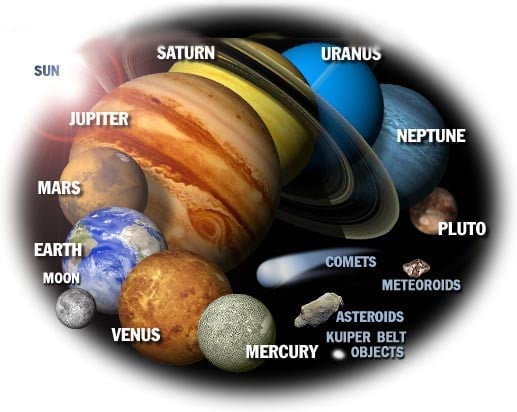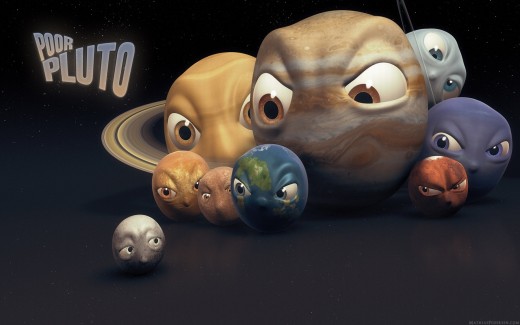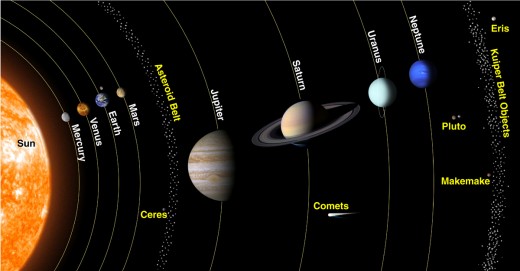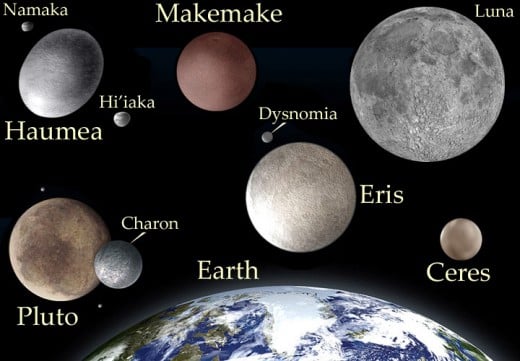Everything you know about who’s in the Solar system could be wrong

As we grew up we learned about the nine planets. Students were taught to recite the planets in order from closest to the sun to the furthest: Mercury, Venus, Earth, Mars, Jupiter, Saturn, Uranus, Neptune and Pluto. However, as technology becomes more advanced, we find that everything we thought we knew about the solar system could be wrong. Our solar system has gone from 9 planets to 8 and now potentially as much as 24.
If we possessed the ability to travel back in time, we would learn ever more about our changing galaxy. For example, in 1850 the record shows that we had 23 planets in the system. Even with their primitive astrological devices, they could see the dwarf planets Ceres, Vesta, Makemake, and Eris. Coincidentally, those are all planets that are now in line to be considered in the same scope as the planet Pluto. As people began seeing patterns in space they were able to better categorize the celestial bodies, and the list was eventually reduced to the 9 we have had for decades.

The problem began with the planet Pluto. In recent years Pluto has been the hot topic of debate. It is a well-know fact that Pluto was a small planet. Pluto was also the furthest out in an area of our solar system called the Kuiper Belt. Since Pluto had its own satellite (or moon for those who are not space pros) it was considered a planet. Even so, since 1970 people have been questioning the status of Pluto especially with the discovery of a larger planet near Pluto called Eris. Finally after much debate, the International Astrological Union (IAU) finally defined what makes a planet in 2006.
The three classifications were that it has to orbit around the sun, which it does. It has to have sufficient mass to assume a nearly round shape (or hydrostatic equilibrium for space buffs), and finally it has to “clear its neighborhood". Clearing the neighborhood essentially means that it is gravitationally dominant and it has no competing planets in its rotation. This last classification is what excluded Pluto as a planet because Pluto shares its space with several other “planets” and all the larger objects in the Kuiper belt. The orbit of Pluto actually comes closer to the sun then Neptune periodically, so it shares more space than one would think. According to the experts, this changes Pluto’s status to a dwarf planet. Still, the plot thickens, and Pluto has not totally been removed from the roster yet.

Instead, the IAU has decided that we should keep Pluto in our solar system and also add the current 5 named dwarf planets in our system. So far, the request has been accepted for three: Ceres, Eris and Pluto. However, there are two more that are strong candidates; makemake and Haumea. The IAU has actually accepted all 5 as dwarf planets, but they are not added to the list of solar system planets yet. There is a big reason for this; so far there is a list of candidates that is 703 “planets” long. It would be very difficult to convince any school board to accept the new list of 703 planets, or even 50 planets. Teaching children about the solar system could become an arduous task. In a time when there are many battles in the education system, the planets of the solar system fall short of most important.

Everything we know about the amount of planets may be wrong, but there is still more to this twisted story. Recent scientific discovery has left the building, and allowed the city of Chicago to speak. The Chicago council has decided to rule that the laws IAU has set forth, do not apply in Illinois. Pluto is still a planet according to their law. Apparently space, logic and time are not out of the range of minor law.
Our existence is an amazing thing. We are discovering new things every day. Nasa said that they discovered and categorized over 1,233 planets this year. They have also found an asteroid made entirely of diamond. Every day is an opportunity to learn and every learning opportunity is promoting further discovery of the place we call home: our solar system.
References
http://curiosity.discovery.com/question/dwarf-planets-in-solar-system
http://www.universetoday.com/15897/solar-system-pictures/
http://flyingsinger.blogspot.com/2009/09/skinny-on-solar-system-sizes.html
http://blog.chron.com/sciguy/2006/08/your-new-solar-system-12-planets-maybe-even-24/
http://www.space.com/12692-dwarf-planets-solar-system-tour.html
http://www.windows2universe.org/our_solar_system/dwarf_planets/dwarf_planets.html
http://jasonirwin.ca/2009/03/07/planet-or-dwarf/









